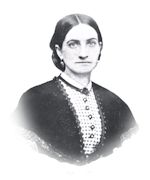September 4.—Mrs. May and myself went up to Chattanooga to-day; Mr. M. accompanied us. We visited two of the hospitals there—one in a church on the top of a hill. We saw few very sick men; they looked to me as if all they needed was plenty of good food. They complained bitterly of their poor diet, and the scarcity of it. I was much pleased to hear them speak highly of their treatment by the ladies in some of the Mobile hospitals.
Within sight of this hospital flowed the Tennessee River. We sat down on its banks and ate our lunch. I was struck with the beauty of the scene around us. The river rolled at our feet.
“Tall rooks and tufted knolls their face
Could on the dark-blue mirror trace.”
And
“Aloft, the ash and warrior oak
Cast anchor in the rifted rock;
And, higher yet, the pine-tree hung
His shattered trunk;
So wondrous wild, the whole might seem
The scenery of a fairy dream.”
This is truly the
“Land of the mountain and the flood.”
I was enraptured with all I saw. The scenery that Scott has so beautifully portrayed was now before me. The day was calm and still, and
“Noontide was sleeping on the hill.”
Chattanooga, the terminus of the Nashville and Chattanooga Railroad and of the Western and Atlantic Railroad, is two hundred and fifty miles from Knoxville by water, and one hundred and forty miles south-east of Nashville. The river runs north-west of it. It is famed for its stone-coal and iron ore. The town is in a valley; the houses are in a dilapidated condition; and, in fact, the whole place ill accords with the beautiful scenery by which it is surrounded.
The Tennessee River is formed of two branches, the Holston and Clinch rivers, which rise among the Alleghany Mountains of Virginia, and unite at Kingston, in Tennessee, and is the largest affluent of the Ohio River. It is very circuitous. After coming to Chattanooga, it turns to the north-west; the Cumberland Mountains oppose it, and change its course southwest. It goes through North Alabama, and touches the state of Mississippi at the north-east extremity, comes back into Tennessee toward the west, and enters the Ohio River at Paducah, in Kentucky.
In the afternoon we paid a visit to another hospital in town, where Mrs. May met an old friend in the surgeon, Dr. Hunter. He was glad to see her, and asked her to come into his hospital; he was going to have it enlarged, and would like to have Mrs. W. and myself, besides Mrs. M., but as Dr. Stout, the post surgeon, did not approve of more than one lady in a hospital, he could not take us without asking him. He took us all through his hospital. It was the upper part of a long row of warehouses, with windows east and west. The partitions between were taken away, making large wards, where a current of air could blow right through. There were some four or five of these rooms opening into each other. The whole was well whitewashed. I thought the smell of the lime was better as a disinfectant than all the camphor or cologne in the world. The name of this hospital is the “Newsom;” so called in honor of the lady I met and admired so much in Corinth.
This place was shelled some few months ago. This morning we took our lunch on a hill opposite to one across the river, where the Federals had planted their guns. They fired into the town without giving any notice. I am told it was a terrible sight to see the women and children running, and the balls flying around them. The Federals took possession of the town, but afterward gave it up. General Ledbetter had command of our forces at that time.



